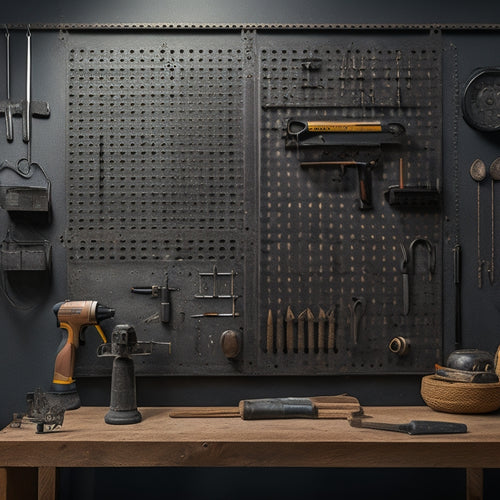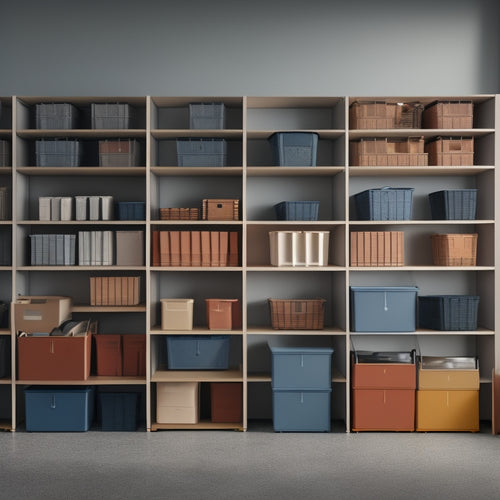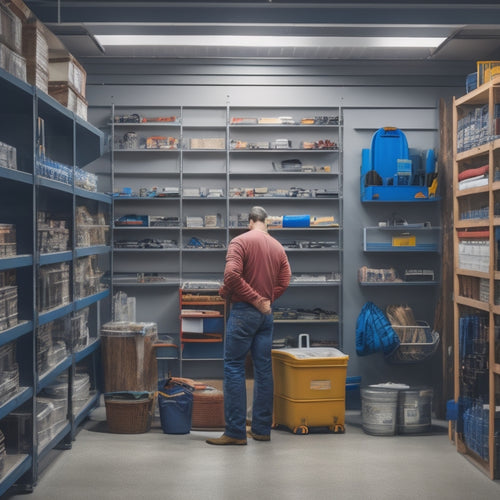
Socket Set Organizers to Maximize Tool Box Space
Share
By investing in a socket set organizer, you can reclaim up to 30 minutes of productivity weekly by maximizing your tool box space. This is achieved through a well-thought-out layout, categorization of tools by type and frequency of use, and efficient tool placement. With a variety of styles and features to choose from, including compact designs and customizable storage solutions, you can optimize your socket set organization to fit your specific workflow needs. By implementing these strategies, you'll not only increase productivity and reduce stress levels but also uncover more efficient ways to work, and continue to refine your toolbox organization system.
Key Takeaways
- A well-organized socket set saves approximately 30 minutes of frustration weekly, increasing productivity and efficiency.
- Customizable storage solutions with color coding and size variations enable easy identification and access to sockets.
- A strategic tool box layout with categorization and labeling sections aids in quick identification of tools and optimizes storage capacity.
- Durable construction and high-quality materials ensure the organizer withstands daily use and prevents tool damage or corrosion.
- Assessing tool box dimensions and socket set size helps create a strategic plan for storage, maximizing capacity and accessibility.
Benefits of Socket Set Organization
Having a well-organized socket set can save you around 30 minutes of frustration each week, which translates to several hours per month. This mightn't seem like a lot, but think about what you could accomplish with that extra time.
You'll be more productive, efficient, and less stressed. A well-organized socket set also guarantees socket accessibility, making it easier to find the right socket when you need it. You'll no longer have to dig through your toolbox, searching for that one socket that's buried beneath a pile of others.
With a visual inventory of your sockets, you'll always know what you have and what's missing. This prevents the risk of using the wrong socket, which can damage your tools, your work, or even cause injury.
A well-organized socket set also reduces the likelihood of lost or misplaced sockets, saving you money in the long run. By organizing your socket set, you'll be able to work more efficiently, safely, and effectively.
Types of Socket Set Organizers
You've likely realized the importance of organizing your socket set, and now you're ready to investigate the various options for keeping your sockets tidy. When it comes to socket set organizers, there are several types to evaluate, each catering to specific socket types and user needs.
Organizer styles range from compact, clip-on designs to large, modular systems. Portability features, such as carrying handles and storage cases, are essential for professionals who need to transport their tools frequently.
Storage solutions can be customized to fit specific socket sets, with design considerations like color coding and size variations helping to guarantee easy identification and retrieval.
Compatibility factors, such as the type of socket drive (e.g., 1/4", 3/8", or 1/2") and the number of sockets, must be taken into account when choosing an organizer.
Layout ideas can also impact the effectiveness of the organizer, with some designs allowing for customization to fit your specific workflow.
Tool Box Space Optimization
You're tasked with maximizing your tool box's storage capacity, and it starts with a well-thought-out layout that considers the size and shape of your socket set organizer.
By optimizing storage capacity, you'll be able to fit more tools in a smaller space, making it easier to find what you need when you need it.
Efficient tool placement is also vital, as it saves you time and reduces frustration when searching for a specific socket or tool.
Tool Box Layout
Within the confines of your tool box, a well-planned layout is vital for maximizing storage capacity and streamlining your workflow. A logical and organized layout guarantees that every tool is easily accessible, reducing the risk of accidents and injuries caused by clutter and disorganization.
To achieve ideal tool accessibility, categorize your tools by type and frequency of use. Store frequently used tools in easy-to-reach locations, while less frequently used tools can be stored in harder-to-reach areas.
Implementing effective organization strategies is important in maintaining a safe and efficient workspace. Label each section or compartment to help you quickly identify where each tool is stored.
Consider a "zone" approach, where specific areas are designated for specific tasks or projects. This keeps related tools and materials together, reducing the need for unnecessary movement and increasing productivity.
Optimize Storage Capacity
Maximize your tool box's storage capacity by taking stock of its dimensions and mapping out a strategic plan. This will help you identify areas where you can optimize storage solutions to fit more tools and accessories. Measure the interior and exterior of your tool box, including the compartments, drawers, and shelves.
Consider the size and shape of your socket sets, wrenches, and other tools to determine the most efficient way to store them. Next, think about the frequency of use for each tool. Store your most frequently used tools in easy-to-reach locations, while less frequently used tools can be stored in harder-to-reach areas.
This will save you time and reduce the risk of accidents caused by digging through cluttered compartments. Regular tool maintenance is also essential to optimizing storage capacity. Clean and lubricate your tools regularly to prevent rust and corrosion, which can take up significant space in your tool box.
Efficient Tool Placement
By allocating specific spaces for each tool, you can create a system that streamlines your workflow and reduces clutter. This is where efficient tool placement comes into play. A well-organized socket set not only saves you time but also reduces the risk of accidents caused by misplaced tools. To achieve ideal tool placement, consider the following socket placement strategies and tool accessibility techniques:
| Socket Size | Storage Location | Accessibility Level |
|---|---|---|
| Small (1/4" - 1/2") | Top tray or front compartment | High |
| Medium (3/4" - 1") | Middle compartment or secondary tray | Medium |
| Large (1 1/4" - 2") | Back compartment or bottom tray | Low |
| Specialty (e.g., impact) | Designated section or separate case | High |
Socket Organizer Materials Matter
You'll quickly realize that the material used to construct your socket organizer is vital to its overall performance and longevity. A durable construction is essential, as it will withstand the rigors of daily use and minimize the risk of damage or breakage.
The material's properties, such as resistance to corrosion or abrasion, will also impact how well your sockets are protected and organized.
Durable Construction Matters
Most socket sets come with a staggering array of pieces, and keeping them organized is essential to getting the most out of your investment. You need a socket set organizer that can withstand the rigors of frequent use and harsh environments. Durable construction matters, and you should prioritize it when selecting an organizer.
Look for organizers made from high-quality construction materials that have undergone rigorous durability testing. A well-built organizer will protect your socket set from damage, ensuring that your tools remain in top condition.
It will also withstand the wear and tear of daily use, reducing the risk of accidents and injuries.
A durable socket set organizer will also save you time and money in the long run. It will reduce the need for frequent replacements and minimize the risk of tool damage.
Material Affects Performance
When it comes to socket set organizers, the material used in their construction plays a significant role in their performance and overall durability. You need to evaluate the material's durability, as it directly impacts the organizer's performance. A high-quality material can withstand the weight of your tools, ensuring they remain organized and within reach.
On the other hand, a low-quality material can lead to a breakdown, causing safety hazards and tool damage.
Here are some key factors to evaluate when assessing the material of your socket set organizer:
-
Corrosion resistance: Will the material withstand exposure to environmental factors like moisture and chemicals?
-
Ease of cleaning: Is the material easy to clean, reducing the risk of dirt and grime accumulation?
-
Temperature tolerance: Can the material withstand extreme temperatures, ensuring it remains stable in various working conditions?
- User preference: Does the material align with your personal preferences, such as a preference for lightweight or heavy-duty organizers?
Size and Capacity Considerations
As you begin to evaluate socket set organizers, size and capacity considerations emerge as a crucial aspect to deliberate on. You'll want to ascertain the organizer can accommodate your socket set's size and quantity, while also leaving enough space for future additions.
Assess your socket set's dimensions, including the socket size and length, to determine the ideal organizer size. Consider the capacity limits of each organizer, factoring in the number of sockets you need to store and how they'll be arranged. A well-designed organizer should have dedicated slots or compartments to keep each socket secure and organized.
When evaluating capacity, think about the types of projects you typically work on and the frequency of use for each socket. This will help you determine the best capacity for your organizer.
Be mindful of overcrowding, as it can lead to disorganization and even damage to your tools. By carefully considering size and capacity, you can find an organizer that efficiently stores your socket set, saving you time and reducing the risk of accidents.
Customization Options for Toolboxes
Flexibility is key when it comes to socket set organizers, and customization options for toolboxes can make all the difference.
You want to guarantee that your toolbox is customized to your specific needs, and that every tool has its designated place. This not only saves you time but also reduces the risk of accidents caused by clutter and disorganization.
When it comes to customization, you have several options to reflect upon:
- Custom tool designs: Work with a manufacturer to create a custom socket set organizer that meets your unique requirements.
- Personalized storage solutions: Design a toolbox layout that accommodates your most frequently used tools, ensuring they're easily accessible.
- Modular components: Invest in modular socket set organizers that can be easily rearranged or added to as your tool collection grows.
- Adhesive-backed organizers: Use adhesive-backed organizers to create a customized storage solution that can be easily removed and rearranged as needed.
Socket Set Organizer Brands
You're likely familiar with top socket brands like DeWalt, Milwaukee, and Craftsman, but when it comes to socket set organizers, you'll want to pay attention to the quality of the organizer itself, not just the brand name.
Organizer quality matters because it directly affects the durability and functionality of your socket set. Look for brands that prioritize organization, storage, and accessibility to get the most out of your tools.
Top Socket Brands
Across the vast terrain of tool manufacturers, a few prominent brands stand out for their exceptional socket set organizers, offering a perfect blend of quality, functionality, and durability.
When selecting a socket set organizer, you want a brand that provides reliable performance, ease of use, and durability.
Here are some top socket brands to evaluate:
-
DeWalt: Known for their rugged and reliable tools, DeWalt socket sets offer a range of features, including ergonomic handles and rust-resistant coatings.
-
Milwaukee: Milwaukee socket sets are renowned for their high-torque performance and impressive socket features, such as their proprietary Milwaukee Hole Saw technology.
-
Craftsman: With a long history of producing high-quality tools, Craftsman socket sets boast exceptional durability and versatility, making them a popular choice among professionals.
- Gearwrench: Gearwrench socket sets are designed for heavy-duty use, featuring innovative socket features like their patented ratcheting system for increased efficiency.
When comparing these top brands, evaluate factors such as socket features, durability, and brand reputation to find the perfect fit for your tool box.
Organizer Quality Matters
While evaluating top socket brands, it's essential to take into account the quality of their socket set organizers, as a well-designed organizer can greatly influence the overall performance and longevity of your tools. A high-quality organizer will guarantee your tools are securely stored, reducing the risk of damage and misplacement.
When reviewing organizer quality, you should consider both functionality and aesthetics. A well-organized layout with clear labels and intuitive design will save you time and frustration.
The organizer's materials and construction should also meet your quality standards, providing durability and resistance to corrosion.
Look for brands that prioritize quality assurance, with rigorous testing and inspection processes in place. A reputable brand will stand behind their products, offering warranties and guarantees that give you peace of mind.
DIY Socket Organizer Projects
By investing a few hours of your weekend, you can create a custom socket set organizer that perfectly suits your needs and preferences.
This DIY approach allows you to design a socket storage solution that accommodates your specific socket set, ensuring easy access and minimizing clutter in your tool box.
Here are some DIY organizer ideas to get you started:
-
Plywood Socket Board: Create a socket board using plywood and attach it to the back of a cabinet door or wall. This provides a compact and accessible socket storage solution.
-
Magnetic Socket Strip: Use a magnetic strip to store sockets on a metal surface, such as a pegboard or tool box wall. This is a great space-saving solution for frequently used sockets.
-
Socket Tray Organizer: Design a socket tray organizer using a plastic or wooden tray and dividers. This keeps sockets organized and protected from damage.
- Socket Holder Box: Build a socket holder box using wood or plastic, with individual compartments for each socket. This is a great option for storing sockets in a compact and portable container.
Socket Set Organization Systems
Your tool box is about to get a whole lot more efficient with the implementation of a socket set organization system. This system guarantees you can quickly find the right socket when you need it, saving you time and reducing frustration.
You'll appreciate the various socket identification techniques, such as color coding systems, that allow you to distinguish between similar-looking sockets. Socket labeling methods also help you identify sockets at a glance.
Magnetic socket holders keep your sockets organized and within reach, while portable socket solutions make it easy to transport your sockets to the job site. For a professional socket setup, consider compact organizer designs that maximize storage capacity.
Don't forget about socket wrench storage – a well-organized socket set is only as good as its accompanying wrench. By implementing a socket set organization system, you'll be able to work more efficiently, reduce tool loss, and improve overall job safety.
Maximizing Toolbox Efficiency
Nearly every tool box has untapped potential for enhancement, and a well-implemented socket set organization system can release it.
By maximizing your toolbox efficiency, you'll experience a significant improvement in your work process. You'll spend less time searching for tools, and more time completing tasks efficiently.
To achieve peak toolbox efficiency, focus on the following key areas:
-
Tool Accessibility: Confirm that frequently used sockets are easily accessible, reducing the time spent searching for them.
-
Socket Identification: Implement a clear labeling system, making it easy to identify the correct socket for the task at hand.
-
Tool Retrieval: Designate a specific place for each socket, allowing for quick and easy retrieval when needed.
- Workspace Organization: Maintain a clutter-free workspace, reducing the risk of accidents and improving overall tool safety.
Frequently Asked Questions
Can I Use a Socket Set Organizer for Other Tool Types?
You can repurpose a socket set organizer for other tool types, like wrenches or pliers, since they often share similar socket types; this approach utilizes the organizer's benefits, keeping your tools tidy and easily accessible for safer, more efficient work.
How Do I Clean and Maintain My Socket Set Organizer?
Are you really using your socket set organizer to its full potential if it's clogged with dirt and grime? You're cleaning yours regularly, right? Use soft-bristled brushes for plastic or metal organizers, and gentle soap for fabric ones, following these socket maintenance tips for a sparkling clean setup.
Are Socket Set Organizers Compatible With All Toolbox Sizes?
When you're shopping for an organizer, you'll find that compatibility largely depends on your toolbox dimensions and the organizer materials used; measure your box carefully to guarantee a snug, secure fit, and opt for organizers made from durable, high-quality materials that can withstand heavy use.
Can I Transfer My Socket Set to a New Organizer?
You'll be delighted to know that, yes, you can transfer your socket set to a new organizer, as long as you choose one that accommodates your socket types, ensuring a seamless changeover and maintaining the organization benefits you've come to rely on.
Do Socket Set Organizers Come With a Warranty or Guarantee?
When shopping for an organizer, you'll find that many brands offer warranty options, ensuring your investment is protected; look for ones that guarantee organizer durability, providing you with peace of mind and a safe, reliable storage solution.
Conclusion
You've optimized your tool box space with a socket set organizer, and now you're wondering: does a clutter-free toolbox really enhance productivity? Research suggests that a well-organized workspace can increase efficiency by up to 30%! With a socket set organizer, you'll spend less time searching for tools and more time tackling projects. The real question is, can you afford not to get organized?
Related Posts
-

Heavy-Duty Pegboard Hooks for Industrial Use
You need heavy-duty pegboard hooks that can withstand the rigors of industrial use, providing a reliable and efficien...
-

Choosing the Right Stacked Storage Bins
When choosing the right stacked storage bins, you'll want to evaluate your storage needs, considering inventory types...
-

Building Garage Shelves in 7 Easy Steps
You're about to convert your garage into a highly functional storage space by building custom shelves in just 7 easy ...


